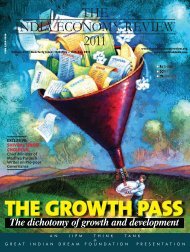Download - The India Economy Review
Download - The India Economy Review
Download - The India Economy Review
Create successful ePaper yourself
Turn your PDF publications into a flip-book with our unique Google optimized e-Paper software.
P LANNING P ARADIGM<br />
out of its revenue proceeds or plan outlay<br />
till date. <strong>The</strong> only sources of money for<br />
the local governments of Bihar are the<br />
grants received from the Central Finance<br />
Commission, besides a promissory share<br />
of three percent in the net tax realization<br />
at the local level (though rules to govern<br />
taxation processes haven’t yet been formulated)<br />
and funds received under two fl agship<br />
schemes of the government of <strong>India</strong>,<br />
i.e. MGNREGA and BRGF. Unfortunately,<br />
the method of execution of these<br />
schemes leaves little control in the hands<br />
of the elected representatives!<br />
Bringing about a Collective Stake<br />
in the Planning Process<br />
In view of the demands of the large scale<br />
district planning exercise, which called for<br />
creation of adequate local capacities for<br />
plans to emerge from as many as 290<br />
Gram Panchayats, 79 Urban Wards, 16<br />
Panchayat Samitis and the Zilla Parishad;<br />
involvement of key stakeholders from<br />
elected governments as well as various<br />
administrative offi ces was felt to be a crucial<br />
pre-requisite. An inception workshop<br />
was held in the beginning of the process,<br />
in recognition of the critical signifi cance<br />
of the involvement of elected local governments<br />
in the planning process. <strong>The</strong><br />
workshop brought together members of<br />
the Zilla Parishad and representatives of<br />
prominent urban local bodies of the district,<br />
who committed their support to the<br />
District Planning process, though marked<br />
with occasional expressions of skepticism<br />
stemming from past experiences, recalling<br />
how most district-level plans in the past<br />
used to be formulated by line departments<br />
or the offi cialdom, bypassing any involvement<br />
of elected representatives. <strong>The</strong>y also<br />
nominated a steering body of people’s<br />
representatives to oversee the process<br />
120 THE IIPM THINK TANK<br />
under the Chairmanship of the District<br />
Magistrate.<br />
Subsequently, the DM played an important<br />
role in convening a workshop of all the<br />
important district level offi cers, including<br />
heads of various line departments and all<br />
the Sub-Divisional Offi cers and Block<br />
Development Offi cers posted in the district,<br />
for a discussion on the signifi cance of<br />
the planning process. <strong>The</strong> workshop<br />
brought about a rare opportunity for the<br />
district level offi cers to collectively analyze<br />
the strengths, weaknesses, opportunities<br />
and constraints faced by the district in<br />
various crucial sectors and to formulate a<br />
roadmap for undertaking the participatory<br />
planning exercise. It also brought about an<br />
air of sanctity regarding the planning process<br />
entrusted to elected local governments.<br />
Subsequently, when the planning process<br />
was rolled out across various local bodies<br />
of the district, it enjoyed the support of a<br />
good range of stakeholders. <strong>The</strong> support<br />
received from various local bodies was due<br />
also to an intensive round of orientation<br />
workshops involving key functionaries<br />
of gram panchayats and<br />
urban local bodies in Vaishali.<br />
Institutional Arrangements for the<br />
Planning Process<br />
One of the most crucial arrangements<br />
contributing to the planning process in<br />
Vaishali was the establishment of a District<br />
Planning and Monitoring Cell<br />
(DPMC), aimed at providing secretarial<br />
support to the District Planning Committee.<br />
<strong>The</strong> Cell played an important role in<br />
liaising with key stakeholders in the district,<br />
facilitating vital communications on<br />
time and in organizing important events.<br />
Endowed with a small team of professionals<br />
and a good balance of essential competencies,<br />
which included skills as diverse<br />
as conducting training, managing databases<br />
and maintaining close contact with<br />
key government offi cials, the team did<br />
well to keep the process on track.<br />
At the local level, steering committees<br />
were formed at the level of each ward to<br />
support the elected representatives in the<br />
planning process. This was a pioneering<br />
arrangement, not envisaged even in the<br />
legislation on local self-governance in<br />
Bihar (i.e. Bihar Panchayati Raj Act<br />
2006). Each set of plan suggestions<br />
emerging from the





